Santa Cruz, Bolivia
- April 1995
[click any picture
to enlarge]
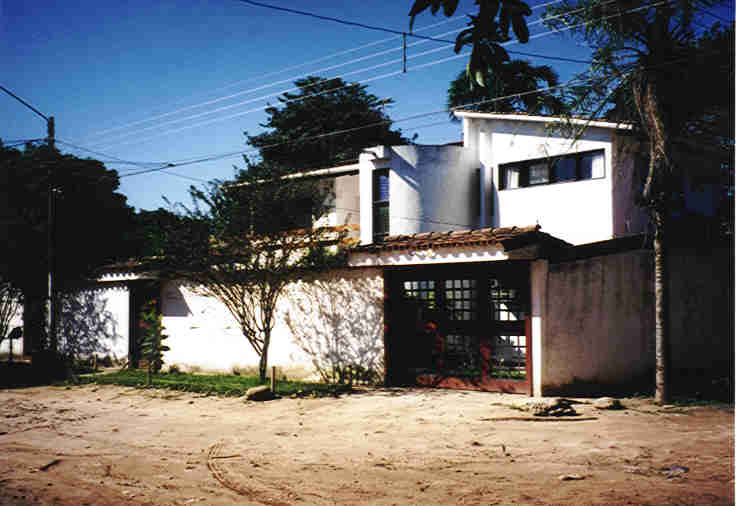 Most people visit Bolivia to go to La
Paz, Lake Titicaca and other remote Andean places that I can't
find on the map. I went to the eastern Andes to visit an
acquaintance I made ten years prior in Australia. This page shows
a few scenes and describes some conditions in and about Santa
Cruz. The first picture to the right is a view of my friend's
home in what you would perhaps call semi-suburban Santa Cruz.
Most people visit Bolivia to go to La
Paz, Lake Titicaca and other remote Andean places that I can't
find on the map. I went to the eastern Andes to visit an
acquaintance I made ten years prior in Australia. This page shows
a few scenes and describes some conditions in and about Santa
Cruz. The first picture to the right is a view of my friend's
home in what you would perhaps call semi-suburban Santa Cruz.
The home is reasonably
up-to-date as we might expect in Southern California, with a
couple exceptions, it's on a mud street, and surrounded by the
fortress like, high concrete block wall with a very heavy secure
gate. One nearly needs a 4X4 vehicle to drive
some of the streets in the rainy season - and it rains a lot. All
of the middle class or above homes in Santa Cruz are totally
enclosed in the high security wall. guarding your property in
less developed countries is a constant concern, perhaps because
it's harder to get it back if you do loose it. For example when
people are traveling for an extended period there is real
possibility that someone else will just "move in" to
their home, pay off the correct authorities, and the owner may
never get it back.
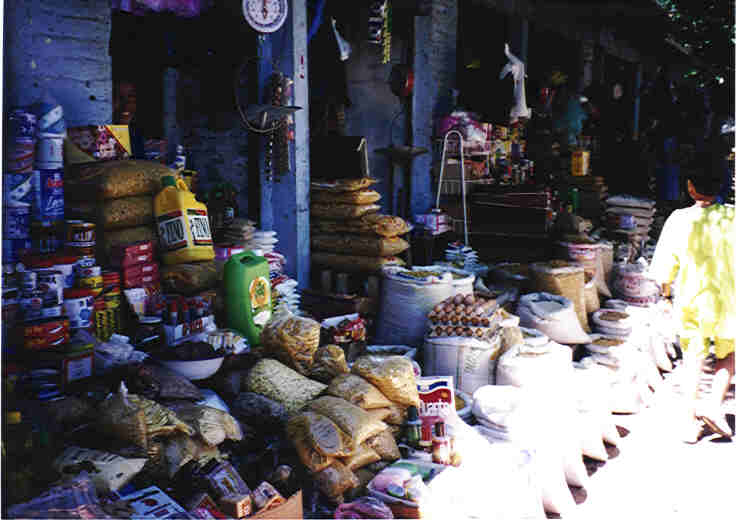 Each morning as Reinhard began his work
day I observed two large bulges, one each of his front pants
pockets. One was his cell phone, they were much larger then than
now, which seemed to be an integral part of his doing business.
The other bulge, maybe an inch to inch and a half thick, was a
large quantity of money - American money. It's a cash economy and
a business man may need a lot. A $20 bill with a corner torn off
is not accepted as payment. My friend claimed the banker would
always slip a couple such damaged bills in his count when he got
money from the bank. he traded a couple of these to me for good
ones that I happened to have.
Each morning as Reinhard began his work
day I observed two large bulges, one each of his front pants
pockets. One was his cell phone, they were much larger then than
now, which seemed to be an integral part of his doing business.
The other bulge, maybe an inch to inch and a half thick, was a
large quantity of money - American money. It's a cash economy and
a business man may need a lot. A $20 bill with a corner torn off
is not accepted as payment. My friend claimed the banker would
always slip a couple such damaged bills in his count when he got
money from the bank. he traded a couple of these to me for good
ones that I happened to have.
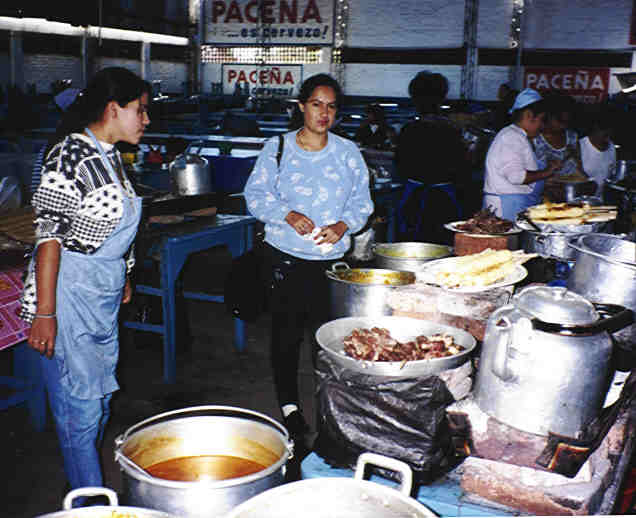 Luly and I went out for a tour of the
city and the market area - El Mercado. The city streets are laid
out in about four concentric rings. So you get on one of the
rings, zip around the city close to your final destination, then
split out - just like the beltway in Washington DC.
Luly and I went out for a tour of the
city and the market area - El Mercado. The city streets are laid
out in about four concentric rings. So you get on one of the
rings, zip around the city close to your final destination, then
split out - just like the beltway in Washington DC.
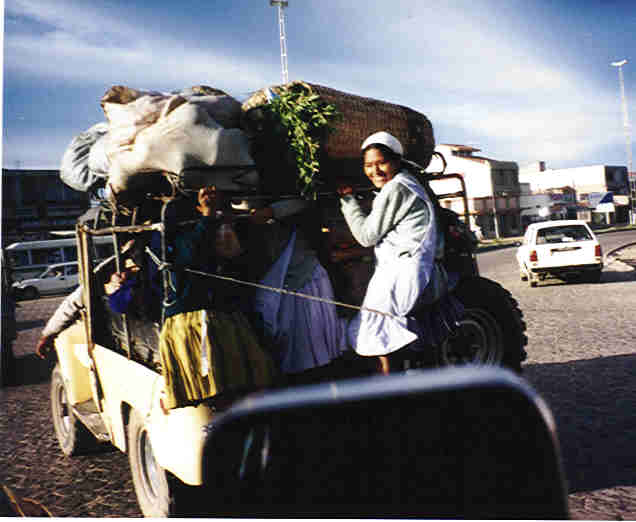 As in most under developed countries
there are many amusing sights. This seems to be a couple
transporting their produce to market.
As in most under developed countries
there are many amusing sights. This seems to be a couple
transporting their produce to market.
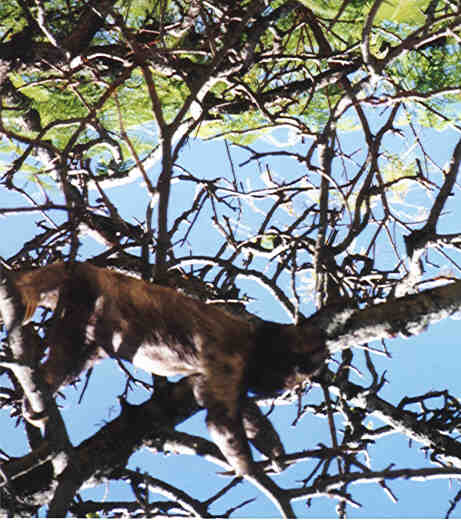 In the central city square, surrounded
by many small shops, a couple catholic churches, and some
government buildings there is a tree-filled park. A number sloths
- these are the animals that move at about one step per minute
-were slothing about in the trees. One is pictured here moving at
about normal speed.
In the central city square, surrounded
by many small shops, a couple catholic churches, and some
government buildings there is a tree-filled park. A number sloths
- these are the animals that move at about one step per minute
-were slothing about in the trees. One is pictured here moving at
about normal speed.
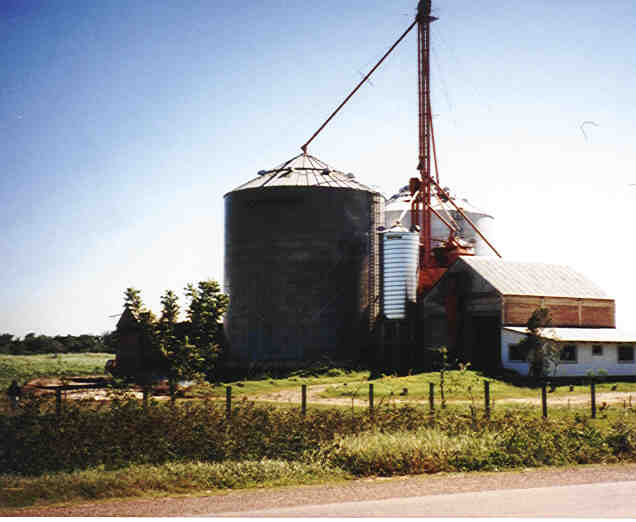 My friend Reinhard did mineral survey
work in the oil fields of much of South America for ten years or
so. However, at this time he had begun a grain silo enterprise a
few miles to the east of Santa Cruz. Pictured here is the silo
complex. these are akin to our mid-western grain elevators. The
grain is generally soy beans or corn. Of course they can't be
mixed, so at the beginning of the season a decision must be made
regarding which grain to handle in a particular silo. Reinhard
was processing soy beans this year.
My friend Reinhard did mineral survey
work in the oil fields of much of South America for ten years or
so. However, at this time he had begun a grain silo enterprise a
few miles to the east of Santa Cruz. Pictured here is the silo
complex. these are akin to our mid-western grain elevators. The
grain is generally soy beans or corn. Of course they can't be
mixed, so at the beginning of the season a decision must be made
regarding which grain to handle in a particular silo. Reinhard
was processing soy beans this year.
As the grain is
harvested it is trucked to complexes like these and sold by the
farmers to the silo operators. The silo operator dries and cleans
the product, and stores, hoping for the optimum marketing time.
It must of course be sold by the next season to make room for new
harvest. When the harvest begins, things get busy. While I was
visiting sometimes 50 tractor-trailer rigs loaded with grain were
lined up at Reinhard's silos. Most came from the eastern low
lands and more from Brasil, just across the boarder. The business
society operated strictly on cash, so a lot had to be available.
Each trailer of grain requires about $2000 cash as I recall.
There is virtually no credit system in place, probably because
there is no legal system in place to seek redress when the
debtors don't pay.
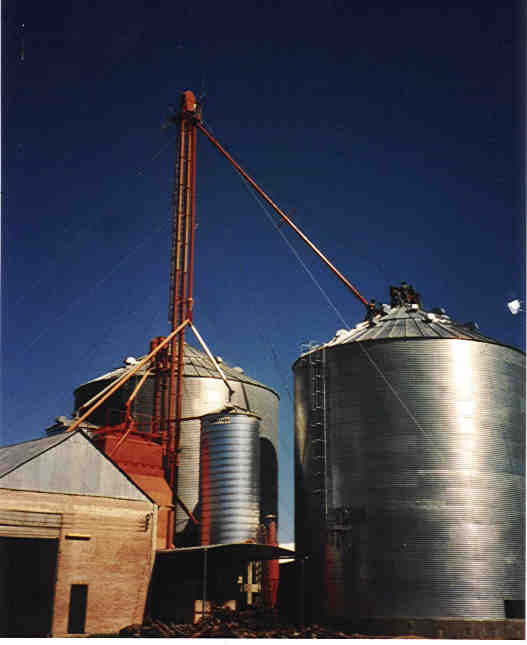 In this picture the brown structure to
the left is the drying kiln. It contains a very large fire box
fuel with wood. The undried grain is temporarily cycled using
conveyors etc. through the small silo in the center and the
drying areas in the kiln until adequately dried. then it is
stored in the large silos. A supervisor and a couple workers must
operate the complex day and night, as trucks arrive constantly in
season and the drying must proceed immediately. It is also
interesting that Reinhard has built his own large scale to weigh
loaded trucks, using pressure transducers and electronics.
In this picture the brown structure to
the left is the drying kiln. It contains a very large fire box
fuel with wood. The undried grain is temporarily cycled using
conveyors etc. through the small silo in the center and the
drying areas in the kiln until adequately dried. then it is
stored in the large silos. A supervisor and a couple workers must
operate the complex day and night, as trucks arrive constantly in
season and the drying must proceed immediately. It is also
interesting that Reinhard has built his own large scale to weigh
loaded trucks, using pressure transducers and electronics.
In the upper
picture the rectangular red brick building to the right is a new
seed cleaning, processing, and storage area, still under
construction at the time of the picture. Reinhard obtained the
bricks from a colony of Chinese just down the road about half
mile in a field. Visiting the 'brick factory," appearances
were that the Chinese group had come to that location and simply
started a business on the land - digging the clay, building
wood-fired kilns with their very own bricks and selling them.
Everyone working there, lived there and no one else.
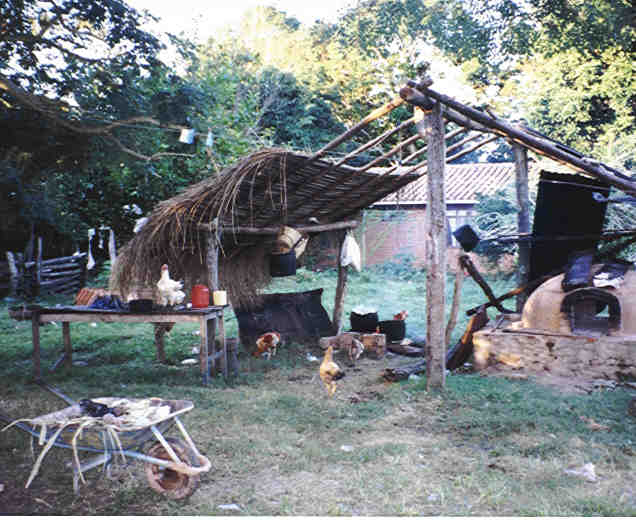 On one occasion we made an excursion
west of town to and old town, whose name I have forgotten, that
pre-dates Santa Cruz and to some of the surrounding jungle. This
picture is one residence in this area. Notice shelter from the
rain and a skylight too. You should have seen the fresh meat in
the wheelbarrow. The stove is in the right-center of the picture.
On one occasion we made an excursion
west of town to and old town, whose name I have forgotten, that
pre-dates Santa Cruz and to some of the surrounding jungle. This
picture is one residence in this area. Notice shelter from the
rain and a skylight too. You should have seen the fresh meat in
the wheelbarrow. The stove is in the right-center of the picture.
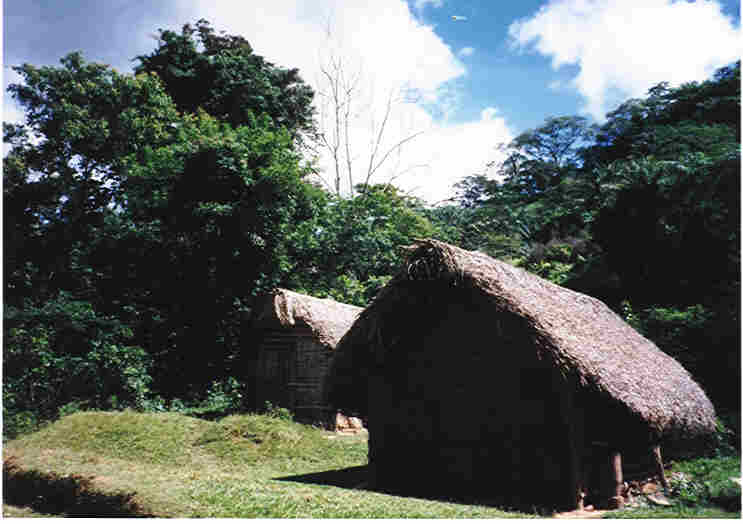 Below we have a middle class home in an area close by.
Below we have a middle class home in an area close by.
 Most people visit Bolivia to go to La
Paz, Lake Titicaca and other remote Andean places that I can't
find on the map. I went to the eastern Andes to visit an
acquaintance I made ten years prior in Australia. This page shows
a few scenes and describes some conditions in and about Santa
Cruz. The first picture to the right is a view of my friend's
home in what you would perhaps call semi-suburban Santa Cruz.
Most people visit Bolivia to go to La
Paz, Lake Titicaca and other remote Andean places that I can't
find on the map. I went to the eastern Andes to visit an
acquaintance I made ten years prior in Australia. This page shows
a few scenes and describes some conditions in and about Santa
Cruz. The first picture to the right is a view of my friend's
home in what you would perhaps call semi-suburban Santa Cruz. 






